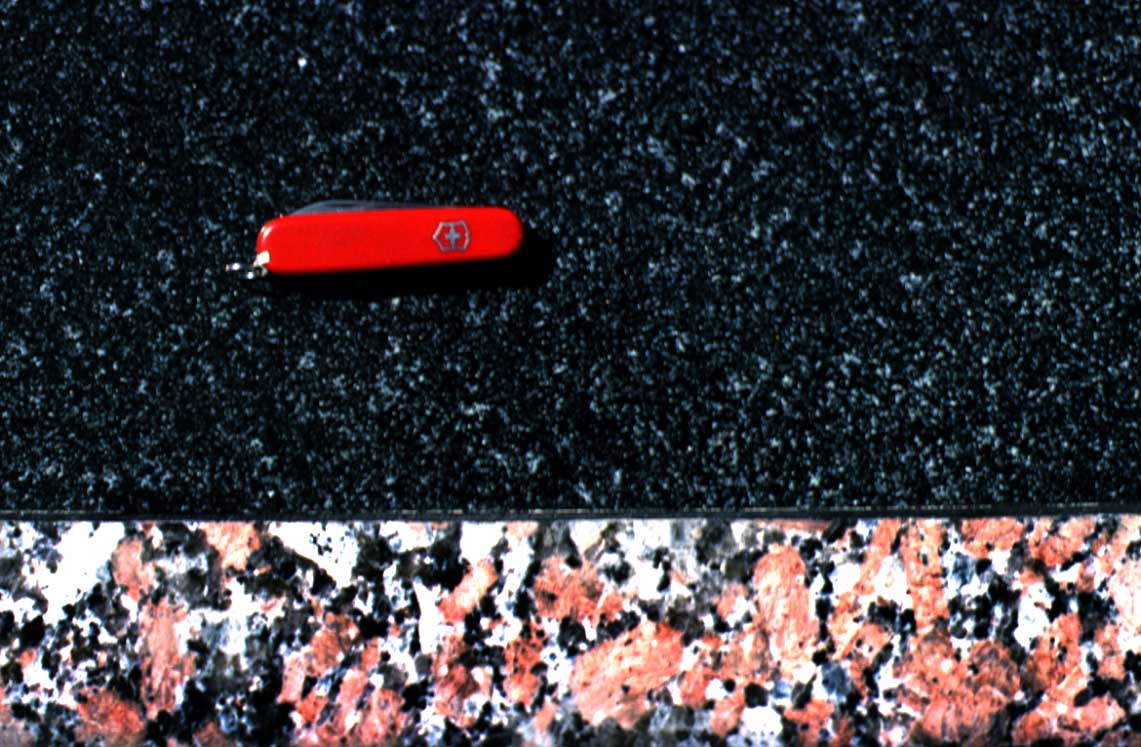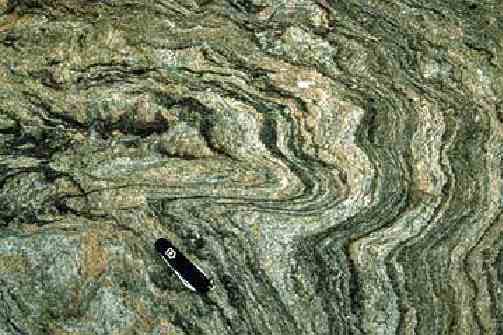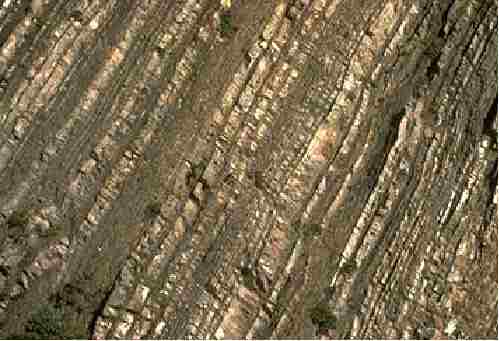
granite (bottom) and gabbro (top) The granite is lighter colored
because
it is richer in silica.
Note that both rock types consist of interlocking crystals.
Some important rock types
All rocks fall into one of three groups: igneous, metamorphic, or sedimentary. Igneous and metamorphic rocks form within the earth at high temperatures. Sedimentary rocks form at the earth's surface. We will spend most of this meeting learning their distinguishing characteristics.
Igneous rocks form by cooling and crystallization from a molten state. Therefore, they consist of interlocking crystals. Intrusive igneous rocks cool and crystallize slowly within the earth and so have coarse grains. Extrusive (volcanic) igneous rocks cool and crystallize rapidly on the earth's surface and so have fine grains. Extrusive rocks frequently contain some larger, well-shaped, crystals surrounding by the fine-grained material.
Igneous rocks are further classified by their chemical composition. The types of minerals in the rock reflect this chemistry. Generally, the richer in silica and oxygen, the lighter colored the rock.

granite (bottom) and gabbro (top) The granite is lighter colored
because
it is richer in silica.
Note that both rock types consist of interlocking crystals.
to see other igneous features, click here.
Metamorphic rocks consist of pre-existing (igneous, metamorphic, or sedimentary) rocks that underwent a change because of high temperatures and usually, pressure. With these high temperatures, the original mineral grains react and change into different types. Clay minerals, for example, will transform into micas. Because the metamorphism usually also involves directed pressures, the newly formed minerals grow in a preferred orientation. Consequently, metamorphic rocks have a crystalline texture and usually show a distinctive layering, called foliation.
You can distinguish foliation from bedding by what forms it. Foliation is formed by oriented crystals; bedding is formed by different sized, rounded grains.
Metamorphic rocks are further characterized by their grain size. In general, the coarser the grain size, the higher "grade", or temperature, of metamorphism.

Folded gneiss. Wind River Range, Wyoming.
Sedimentary rocks consist of particles (sediment) worn from pre-existing rocks. They may be clastic sedimentary rocks, where the sediment consists of gravel, sand, silt, clay, chemical sedimentary rocks, where the sediment consists of precipitated materials (eg. salt), or biogenic sedimentary rocks, where the sediment consists of biologically produced material (eg. shell fragments). The sediment accumulates in layers, and through time, becomes glued together through the action of groundwater.
Therefore, sedimentary rocks consist of individual, worn, particles.
Most of these particles are visible with a handlens. At the scale of an
outcrop, you should also be able to see the layering, called "bedding".
Single hand specimens are usually too small to show bedding. The photo
on the far right below, shows bedding--defined by alternating beds of
sandstone
and shale.

conglomerate |

sandstone |

interbedded sandstone and shale |
click here to see some other sedimentary features
Volcanic Rocks: porphyritic texture and phenocrysts.
Many volcanic rocks contain larger crystals that are set in a
fine-grained
matrix. These crystals, called "phenocrysts", are relatively
large
because they crystallized slowly, prior to eruption of the magma.
Once erupted, the remaining liquid part of the magma crystallized
rapidly
to form the fine-grained part of the rock. A volcanic rock with
abundant
phenocrysts is called "porphyritic".
Essential Volcanic rock types: Basalt, andesite, rhyolite.
Depending on its silica content, volcanic rock is classified as either
basalt (50-60% SiO2), andesite (60-70% SiO2), or rhyolite (>70%
SiO2).
These compositional differences are reflected in the specific minerals
found in each rock--and these mineralogical differences make it fairly
easy to distinguish the rocks.
Basalt ( ): rich in plagioclase
and pyroxene. Typically a very dark to black rock.
phenocrysts may be plagioclase or olivine.
Andesite ( ): rich in plagioclase, amphibole, and K-spar. Typically a gray to dark gray rock. Phenocrysts are typically plagioclase and/or amphibole.
Rhyolite ( ): rich in k-spar,
plagioclase,
quartz. Typically a light-gray to pink- colored
rock.
Phenocrysts are quartz and/or amphibole.
Some Pyroclastic Materials: ash, pumice, tuff.
Pyroclastic material, also called "tephra", is the material that is
ejected from a volcano during an explosive eruption. The finest
grained
of these materials is ash, which in large part, consists of tiny shards
of glass. Pumice is also glass, but is so full of air holes that
it will float on water. Tuff is a rock that consists of
consolidated
pyroclastic materials.
rock ( ) ash make sure you look at it down the binocular microscope.
rock ( ) pumice make sure you look at it with a handlens to confirm that it is mostly glass.
rock ( ) tuff try to find a piece of
pumice
within this rock.
And... Obsidian
Obsidian is black or brown volcanic glass that is rhyolitic in
composition.
Some unidentified rocks.
Identify the following rocks as either igneous (note whether intrusive or volcanic), metamorphic, or sedimentary.
Rock 1 _________________
Rock 2 _________________
Rock 3 _________________
Rock 4 _________________
Rock 5 _________________
Back to Geology of the National Parks